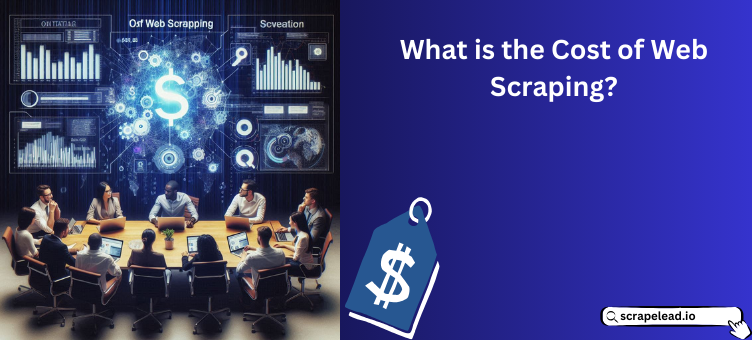What is the Cost of Web Scraping?
 ScrapeLead
ScrapeLead
Web scraping is a necessary tool for businesses and researchers wanting to pull valuable information from the web. From monitoring competitors to price monitoring to lead gathering, web scraping can be an affordable option. But how much does web scraping actually cost?
In this guide, we’ll break down the cost of web scraping, including factors that influence pricing, different pricing models, and ways to optimize your budget.
Factors That Influence the Cost of Web Scraping
The cost of web scraping varies widely depending on several factors. Here are the key elements that affect pricing:
1. Type of Web Scraping
One-time scraping: If you need data from a website just once, the cost will be lower than continuous or real-time scraping.
Real-time scraping: Requires more resources and is generally more expensive due to infrastructure and maintenance costs.
2. Complexity of the Website
Simple websites: Sites with clean HTML and minimal anti-scraping measures are cheaper to scrape.
Complex websites: Sites with JavaScript rendering, CAPTCHA, login requirements, or anti-bot protections require advanced techniques, increasing costs.
3. Volume of Data
Small-scale scraping: If you're scraping a few hundred or thousand records, the cost is relatively low.
Large-scale scraping: Extracting millions of records requires more powerful servers and data processing capabilities, making it more expensive.
4. Frequency of Scraping
One-time scraping: Lower cost since it only runs once.
Daily/Weekly scraping: Requires more resources, increasing the overall cost.
Real-time scraping: Most expensive due to continuous server usage and maintenance.
5. Infrastructure and Tools
DIY web scraping: Using free tools like BeautifulSoup or Scrapy reduces costs but requires programming knowledge.
Cloud-based scraping services: Tools like ScraperAPI or Octoparse provide automation but come with subscription costs.
Custom-built scrapers: If you hire a developer or agency, the initial setup cost can be high.
Web Scraping Pricing Models
1. DIY Web Scraping (Free to Low Cost)
If you have coding skills, you can scrape websites using free tools like:
BeautifulSoup (Python)
Scrapy (Python)
Selenium (for JavaScript-heavy websites)
Cost: Free (except for hosting and proxies if needed)
2. Web Scraping Software (Subscription-Based)
Several platforms offer ready-made scraping solutions with easy-to-use interfaces. Some popular ones include:
Octoparse
ScrapeLead
ParseHub
Scrapy Cloud
Cost: $20–$500 per month, depending on features and data limits.
3. Web Scraping Services (Outsourced Solutions)
If you don’t want to manage web scraping yourself, you can hire a professional service to do it for you. These services often charge based on:
Number of pages scraped
Data volume
Customization required
Cost: $100–$10,000+ per month, depending on complexity.
4. Custom Web Scraping Development
Hiring a developer or agency to build a custom scraper for you is a good option if you need highly specialized data extraction.
Cost: $500–$50,000 (one-time setup) + ongoing maintenance fees.
Additional Costs to Consider
1. Proxy and VPN Costs
To avoid getting blocked, many scrapers use proxy servers.
Free proxies: Risky and slow.
Paid proxies: More reliable and faster, starting at $10–$500 per month.
2. CAPTCHA Solving Services
Some websites use CAPTCHA to prevent scraping. Solving services like 2Captcha or Anti-Captcha cost around $2–$10 per 1,000 requests.
3. Cloud Storage & Processing
If you scrape large amounts of data, you’ll need storage solutions like:
Google Cloud, AWS, or Azure
Databases like MongoDB or PostgreSQL
Cost: $10–$1,000 per month, depending on storage size.
How to Reduce Web Scraping Costs
Here are some tips to optimize your web scraping budget:
Use open-source tools: Instead of paying for expensive software, use free libraries like Scrapy and BeautifulSoup.
Optimize your scraping frequency: Avoid unnecessary scraping by scheduling data extraction only when needed.
Leverage caching: Store previously scraped data to reduce redundant requests.
Use efficient proxies: Instead of buying expensive proxies, use rotating residential proxies to avoid detection.
Outsource smartly: Compare different scraping services to find the best value for your needs.
Conclusion
The price of web scraping varies on several aspects, such as website complexity, amount of data, and frequency of scraping. DIY web scraping is the most affordable option, but companies with more extensive needs might need to use paid software or outsource services.
If you want cost-efficient and effective web scraping options, utilize a combination of free resources, automation platforms, and proxies in order to balance your budget.
Need help with web scraping? Let us know in the comments! And don’t forget to share this article with others who might find it useful!
Know More \>> https://scrapelead.io/blog/what-is-the-cost-of-web-scraping/
Subscribe to my newsletter
Read articles from ScrapeLead directly inside your inbox. Subscribe to the newsletter, and don't miss out.
Written by

ScrapeLead
ScrapeLead
Scrape Any Website and Connect With Your Popular Apps It’s easy to connect your data to thousands of apps, including Google Sheets and Airtable. You can utilize Zapier, http://scrapelead.io’s API, and more for smooth data sharing and integration across multiple platforms.